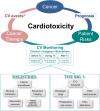Cardiac Imaging in Oncology Patients in Europe: a Model for Advancement of CV Safety and Development of Comprehensive CV Care
- PMID: 32583314
- PMCID: PMC7314619
- DOI: 10.1007/s12265-020-10028-1
Cardiac Imaging in Oncology Patients in Europe: a Model for Advancement of CV Safety and Development of Comprehensive CV Care
Abstract
Cancer therapy-related cardiovascular events are widely recognized as a global problem, and cardio-oncology has been proposed as a new approach to coordinate preventive strategies in oncologic patients. Cardiac imaging plays a critical role in this process. This article summarizes current practices and future needs in cardiac imaging to improve the cardiovascular surveillance of cancer patients.
Keywords: Cancer; Cardiac imaging; Cardio-oncology; Echocardiography.
Conflict of interest statement
The author declares that she has no conflict of interest.
Figures

References
-
- Mehta LS, Watson KE, Barac A, et al. Cardiovascular disease and breast cancer: where these entities intersect. A Scientific Statement from the American Heart Association, American Heart Association Cardiovascular Disease in Women and Special Populations Committee of the Council on Clinical Cardiology; Council on Cardiovascular and Stroke Nursing; and Council on Quality of Care and Outcomes Research. Circulation. 2018;137:e30–e66. doi: 10.1161/CIR.0000000000000556. - DOI - PMC - PubMed
Publication types
MeSH terms
Substances
LinkOut - more resources
Full Text Sources
Medical

